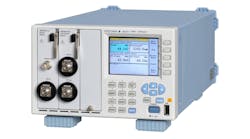Yokogawa launched updated versions of its AQ2200 optical sensor modules. The AQ2200-212 single-channel optical sensor module offers an analog output port, and the AQ2200-222 has two channels. Designed to work with the AQ2200 series frame controllers, the new modules offer improved performance over the existing AQ2200-221.
Both modules have improved measurement performance and low uncertainty. The AQ2200-212 and the AQ2200-222 both offer a power range from +15 to -90 dBm, compared to the AQ2200-221’s figure of +10 to -70 dBm. The modules can also achieve a seamless measurement of approximately 30 dB without switching the measurement range.
The modules also have an improved uncertainty of ±2.5%, compared to their predecessor’s figure of ±3%. Minimum averaging time has been halved to 100 µs, compared to the AQ2200-221’s 200 µs. Other performance figures include a wavelength range from 800 to 1700 nm and a polarization dependence of 0.02 dB.
The new AQ2200 optical sensor modules are ideal for manufacturers of active optical devices and components who need to test products such as lasers, optical transceivers, and optical amplifiers. They will also suit the needs of passive component manufacturers producing items such as optical fibers, optical connectors, and optical couplers, as well as manufacturers of optical transmission systems.
Suitable for a range applications demanding high accuracy, one of the main applications is I/L curve (drive current/optical power) measurement of laser diode modules. Because the single-range power range of the updated sensor module is as wide as 30 dB, the I/L curve characteristics can be measured accurately, quickly and seamlessly.
Another application is the stress-testing of optical fiber cables. The ability of an optical fiber cable to resist impact is evaluated by measuring the momentary optical interruption and optical attenuation, as well as the degree of impact. Multiple AQ2200-212s allow optical inputs from the fibers to be measured following the application of a shock load, with the corresponding data sent to a data recorder via the analog outputs.
